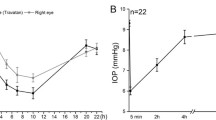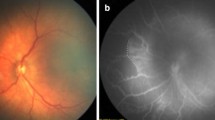Abstract
We conducted an extensive histological study of the retinas of newborn rats that had been exposed to hyperoxic conditions. Our aim was to verify whether it is possible, using oxygen alone, to induce retinal detachment, a lesion that is characteristic of the more advanced stages of retinopathy of prematurity (ROP). Eight litters (total number of animals: 64) of newborn, albino Wistar rats were used. Four litters (32 rats) were exposed to 80% oxygen for the first ten days of life. Some of these rats were then removed to room-air environments where they were kept for two, three or four more weeks. The other four litters (32 rats) were maintained for the entire period in room-air. On the 11th, 25th, 32nd and 39th days of life rats from both the exposed and control groups were sacrificed and 5 micron sections of their in toto eyeballs were submitted to histological evaluation and immunohistochemical studies.
Folding of the internal retinal layers was observed in some of the animals exposed to hyperoxia, as well as those kept in room air. These folds did not alter the overall thickness of the retina itself and were probably congenital.
Retinal folds and microdetachments were seen in many of the retinas from the exposed group of rats. Extensive detachment was observed in one of the rats sacrificed after two weeks of room-air recovery, in two of those recovered for three weeks and in two exposed to four weeks of room air. The sections containing these areas of retinal detachment showed marked increases in glial fibrillary acidic protein (GFAP) in immunocytochemical studies, suggesting that Müller cells might play a role in the pathogenesis of retinal detachment.
Similar content being viewed by others
References
Hittner HM, Rudolph AJ, Kretzer FL. Suppression of severe retinopathy of prematurity with vitamin E supplementation: ultrastructural mechanism of clinical efficacy. Ophthalmol 1984; 91: 1512–22.
Kretzer FL, Hittner HM. Initiating events in the development of retinopathy of prematurity. In: Silverman WA, Flynn JT (eds): Contemporary Issues in Fetal and Neonatal Medicine. 2, Retinopathy of Prematurity. Blackwell Scientific Publications 1985; 121–52.
Foos RY. Chronic retinopathy of prematurity. Ophthalmol 1985; 92: 563–74.
Ashton N. Donders Lecture 1967. Some aspects of the comparative pathology of oxygen toxicity in the retina. Br J Ophthalmol 1968; 52: 505–31.
Silverman WA. Retinopathy of prematurity: Oxygen dogma challenged. Arch Dis Chil 1982, 57: 771–3.
Gole GA. Animal models of retinopathy of prematurity. In Silverman WA, Flynn JT (eds): Contemporary Issues in Fetal and Neonatal Medicine. 2, Retinopathy of prematurity. Blackwell Scientific Publications 1985; 53–95.
Flower RW, Blake DA. Retrolental fibroplasia: role of the prostaglandin cascade in the pathogenesis of oxygen induced retinopathy in the newborn beagle. Pediat Res 1981; 15: 1293–1302.
Ricci B. Effects of hyperbaric, normobaric and hypobaric oxygen supplementation on the retinal vessels in newborn rats: a preliminary study. Exp Eye Res 1987; 44: 459–64.
Ricci B, Calogero G. Oxygen-induced retinopathy in newborn rats: effects of prolonged normobaric and hyperbaric oxygen supplementation. Pediatrics 1988; 82: 193–98.
Gole GA, Browning J, Elts SM. The mouse model of oxygen-induced retinopathy: A suitable animal model for angiogenesis research. Doc Ophthalmol 1990; 74: 163–69.
Deneke SM, Fanburg BL. Normobaric oxygen toxicity of the lung. N Engl J Med 1980; 303: 76–86.
Lai VL, Rana MW. Folding of photoreceptor cell layer: a new form of retinal lesion in rat. Invest Ophthalmol Vis Sci 1985; 26: 771–4.
Phelps DL, Rosenbaum AL. The role of tocopherol in oxygen induced retinopathy: kitten model. Pediatrics 1977; 59 (suppl): 998–1005.
Poulsom R, Hayes B. Congenital retinal folds in Sheffield-Wistar rats. Graefe's Arch Clin Exp Ophthalmol 1988; 226: 31–3.
Anderson DH, Stern WH, Fisher SK, Erickson PA, Borgula GA. Retinal detachment in the cat: the pigment epithelial-photoreceptor interface. Invest.Ophthalmol Vis Sci 1983; 24: 906–26.
Erickson PA, Fisher SK, Anderson DH, Stern WH, Borgula GA. Retinal detachment in the cat: the outer nuclear and outer plexiform layers. Invest Ophthalmol Vis Sci 1983; 24: 927–42.
The International Committee for the Classification of the Late Stages of Retinopathy of Prematurity: An international classification of retinopathy of prematurity II. The classification of retinal detachment. Arch Ophthalmol 1987; 105: 906–12.
Lazarides E. Intermediate filaments as mechanical integrators of cellular space. Nature 1980; 283: 249–56.
Bignami A, Dahl D. The radial glia of Müller in the rat retina and their response to injury. An immunofluorescence study with antibodies to the glial fibrillary acidic (GFA) protein. Exp Eye Res 1979; 28: 63–9.
Lewis GP, Erickson PA, Guérin CJ, Anderson DH, Fisher SK. Changes in the expression of specific Müller cells protein during long-term retinal detachment. Exp Eye Res 1989; 49: 93–111.
Erickson PA, Fisher SK, Guérin CJ, Anderson DH, Kaska DD. Glial fibrillary acidic protein in Müller cells after retinal detachment. Exp Eye Res 1987; 44: 37–48.
Penn JS, Thum LA, Rhem MN, Dell SJ. Effects of oxygen rearing on the electroretinogram and GFA-Protein in the rat. Invest Ophthalmol Vis Sci 1988; 29: 1623–30.
Eisenfeld AJ, Bunt-Milam AH, Sarthy PV. Müller cell expression of glial fibrillary acidic protein after genetic and experimental photoreceptor degeneration in the rat retina Invest Ophthalmol Vis Sci 1984; 25: 1321–28.
Author information
Authors and Affiliations
Rights and permissions
About this article
Cite this article
Calogero, G., Ricci, B. Experimental oxygen-induced retinal detachment in the newborn Wistar rat. Doc Ophthalmol 87, 315–329 (1994). https://doi.org/10.1007/BF01203341
Accepted:
Issue Date:
DOI: https://doi.org/10.1007/BF01203341




